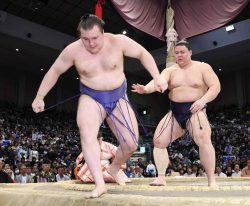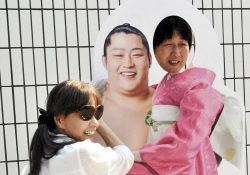
The five ringside judges confer in the ring about a decision made during a bout at Tokyo’s Ryogoku Kokugikan in January 2022.
13:06 JST, November 13, 2024
As the current crop of wrestlers puts it all on the line in the ring, you will find a number of sumo greats of the past sitting outside of it in the front row. Clad in ceremonial crested hakama, the five are sumo elders who make up the so-called ringside judges.
From their vantage point, they keep a close eye on the matches. If one has a doubt about the decision made by the referee in the ring, he immediately raises his hand in objection. The group then ascends into the ring to discuss the matter and decide whether the initial judgment was right or wrong.
But the decision is not solely based on what they themselves saw with their naked eyes. They communicate with another elder stationed in a room in the arena equipped to check the video footage, a system that makes sure that as accurate a decision as possible is made. Quite often even that is not enough to determine a winner, and a rematch is ordered.
While the sumo world is generally regarded as rigidly conventional, it is in fact a pioneer in the Japanese sports world when it comes to adopting video replay to assist in deciding close calls.
At the 1969 Spring Grand Sumo Tournament, legendary yokozuna Taiho saw his record of 45 consecutive wins came to an end at the hands of a rank-and-file wrestler named Toda. Video footage and photographs, however, later confirmed that Toda’s foot had actually touched down out of the ring first, causing a huge uproar. It became known as “the great misjudgment of the century.”
Video replay to assist in judging decisions was launched at the following tournament in May. In recent years, pro baseball and soccer have adopted rules to allow for challenges using video replays, but sumo has had its system in place for 55 years — a testament to the surprising level of innovation of Japan’s national sport.
Even so, I want to emphasize that video is only a tool for reference. The highest priority is placed on what is actually seen by the eyes of ringside judges.
They are asked to make an overall judgment from their perspective as pros. It goes beyond whether a foot simply went out of the ring. There are other factors that come into play, such as the flow of the match or whether an opponent had lost his balance. Were they in a position from which they had no chance of recovering?
This is why opinions sometimes differ between the judges. It is difficult to explain in theory, but I think it stems from the depth of sumo. What do you think about it?
— Kamimura is a sumo expert.
"Sports" POPULAR ARTICLE
-

Speed Skater Yukino Yoshida Clinches Ticket to Milan
-

Yoshinobu Yamamoto Cheered by Los Angeles Lakers Fans at NBA Game
-

Kenta Maeda Joins Rakuten Eagles; Returns from American MLB to Japanese Pro Baseball for First Time Since 2015
-

Maruyama’s Ski Jump Streak Snapped
-

Sumo Wrestler Aonishiki ‘Gives Courage to Ukraine,’ Says Childhood Mentor
JN ACCESS RANKING
-

Tokyo Economic Security Forum to Hold Inaugural Meeting Amid Tense Global Environment
-

Keidanren Chairman Yoshinobu Tsutsui Visits Kashiwazaki-Kariwa Nuclear Power Plant; Inspects New Emergency Safety System
-

Imports of Rare Earths from China Facing Delays, May Be Caused by Deterioration of Japan-China Relations
-

University of Tokyo Professor Discusses Japanese Economic Security in Interview Ahead of Forum
-

Japan Pulls out of Vietnam Nuclear Project, Complicating Hanoi’s Power Plans

























